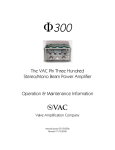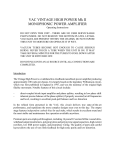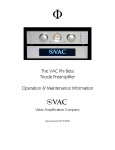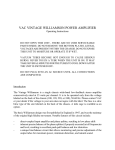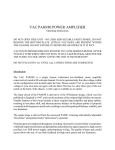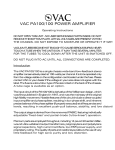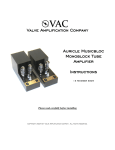Download VAC Phi 220 Specifications
Transcript
F220
F110/110
The VAC
Phi Two Twenty
Monophonic Beam
Power Amplifier
&
Phi 110/110 Stereo
Beam Power Amplifier
Operation & Maintenance Information
Valve Amplification Company
Manual issued 01/24/2004
Revised 07/02/2004
PLEASE READ CAREFULLY
Your Phi Beam Power amplifier is fitted with a unique output tube monitoring circuit. Rather than
directly contacting the audio path, and thus contaminating the pure sound, the temperature of a
small cathode resistance is sensed. The four bi-color LED’s on the front panel indicate the tubes’
conditions.
If the idle current of a KT88 output tube drops below nominal limits, the LED corresponding to that
tube will light green. This indicates that either the bias setting for that tube should be adjusted, or
the tube should be replaced at your convenience, but it is safe to continue operating the amplifier.
The exact idle current of each tube may be tested by means of the meter and the test switches
located on the front panel. The associated bias control should be adjusted so that the needle
points directly at the dot in the center of the meter. When no test switch is selected, the meter
indicates the incoming ac voltage (wall voltage).
Note: These LED’s will also be green when the amplifier is first switched on, and will extinguish when
the bias resistors have reached full operating temperature after approximately 30 minutes. The
threshold between green and no illumination is not precise; do not be overly concerned if some
positions take longer to extinguish. The condition of individual tubes may be checked with the built
in meter.
Note: a strong air current could cause the lights to remain green even in normal operation.
In the event that any output tube draw excessive idle current (a “run away” tube or a tube not
biased correctly), the high voltage supply in the amplifier will shut down automatically and the LED
corresponding to the problematic KT88 tube will indicate red. The red light will stay on until the
power switch is turned off. This tube must be replaced. (Note: The LED’s for the other tubes will
show green after a few minutes...this should be disregarded.)
To minimize difficulties, always source genuine VAC Tested audio tubes for your Phi.
CAUTION
THE AMPLIFIER AND POWER SUPPLY CONTAIN NO USER SERVICEABLE PARTS. DO NOT REMOVE THE
BOTTOM PLATES OR CHASSIS COVERS. LETHAL VOLTAGES ARE PRESENT WITHIN THE CHASSIS. DO
NOT OPERATE THE UNITS IF THEY ARE WET.
VACUUM TUBES BECOME HOT ENOUGH TO CAUSE SERIOUS BURNS. NEVER TOUCH A TUBE WHEN
THE UNIT IS ON. IT MAY TAKE SEVERAL MINUTES FOR THE TUBES TO COOL DOWN AFTER THE UNIT
IS SWITCHED OFF. IT IS STRONGLY RECOMMENDED THAT THE TUBE COVERS BE LEFT IN PLACE AT ALL
TIMES.
THE TUBE COVERS WILL BECOME HOT IN NORMAL OPERATION. DO NOT SET OR SPRAY ANYTHING
ON THEM.
THE AMPLIFIER AND POWER SUPPLY ARE HEAVY. IT IS ADVISABLE TO HAVE ASSISTANCE IN
UNPACKING, MOVING, AND SETTING UP. BE SURE TO USE PROPER LIFTING TECHNIQUES TO AVOID
BACK STRAIN AND INJURY. BE CERTAIN TO INSTALL IT IN A SECURE LOCATION FROM WHICH IT CAN
NOT FALL OR TIP OVER.
INDEX
Introduction
Unpacking & Assembly
Installation
Input connectors
Operation
Feedback
Triode & Ultra-Linear Modes
Illuminated Logo
Installing New Output Tubes
Biasing & Checking Output Tube Condition
Replacement of Low Level Tubes
Care Of Chassis
Tips and Advice
A Word About Tubes in General
Output Tubes
Low Level Tubes
Impedance Matching
Grounding
Tuning Your System
Specifications
Footnotes
Warranty & Registration Form
1
INTRODUCTION
The Phi Beam Power amplifiers are unique power amplifiers, and the most power and detailed in
VAC’s history. Excellent linearity is achieved without resorting to loop negative feedback, for a more
natural, dimensional sound.
A total of four KT88 are used in Class A1. Uniquely, each is provided with a separate DC heater
supply to ensure that no undesirable couplings occur; only the intended ideal signal path exists.
The input circuitry of the Phi is derivative of the unique Williamson circuit, which provides pure,
direct coupled, inherently balanced input amplification and phase splitting. Type 6SN7/5692 octal
twin triodes do the honors.
Two superb VAC output transformer, interconnected in a way that allows high power to be
delivered with the sonic purity of low power devices, provide superb voltage/current translation,
allowing impedances from eight ohms to as low as one ohm to be driven.
The main chassis is machined from thick aluminum. The separate power supply allows e.m.f. fields,
switching transients, and mechanical vibration to be isolated from the audio circuits. The high
voltage supply utilizes dual choke pi filtering for extremely low noise.
The Phi Beam Power amplifiers are designed not to the latest fad but to substance, for the highest
possible sound quality. Time spent familiarizing yourself with this manual will be well rewarded.
2
UNPACKING & ASSEMBLY
The vacuum tubes and glass covers are packed individually to prevent damage, and must be fitted
to the amplifier before installation can proceed.
Remove the four screws that secure the aluminum top frame to the chassis
pillars using the tool provided. Turn counterclockwise to remove.
Wear the supplied cotton gloves to minimize the chance of fingerprinting
the nickel plated chassis. Wipe any oils off immediately.
Take care to prevent the tool from scratching the chassis.
Remove the top frame.
From each of the four columns remove the tape, which prevented the
nylon setscrews from coming loose during shipment.
Slide the side and rear glass plates into the pillars’ channels.
Note that the rear glass is slightly wider than the side glasses.
The glass will not go all the way to the chassis top, but has a gap at the
bottom for air flow.
Take care not to scratch or break the glass.
3
The front glass has the etched VAC logo. Install this between the front pillars.
Take great care not to scratch this glass.
The front glass fits into a small channel in the front plate.
Tighten the white nylon setscrews that secure the rear glass and side
glasses. Turn clockwise to tighten.
There are four setscrews for each glass plate.
Do not tighten the setscrews for the front glass yet.
Install the six aluminum blocks at the top of the rear glass and side glasses.
If there is a ‘dimple’ in the block, it should face the outside of the amplifier.
Tighten the metal setscrews that secure each block using the allen key
supplied. Turn clockwise to tighten.
Replace the aluminum top frame.
Ensure that the front glass fits into the groove in the top frame.
Ensure that the top frame sits flush in the pillars.
Replace the four screws that secure the top frame. Turn clockwise to
tighten.
(Note: photo does not show the tubes or glass, which should be installed
by this time.)
4
Tighten the four white nylon setscrews that secure the front glass using the
tool provided. Turn clockwise to tighten.
Do not over tighten.
Install the vacuum tubes.
Each tube or its box has a “V” number, which corresponds to the labels on the top plate of the
amplifier; these indicate where each tube should be installed.
Fit each tube into the matching socket, first removing any sticker from the amplifier and/or the tube.
When inserting and removing tubes, handle them by their bases, not by their glass bulbs.
Note that there is a locator pin on the octal (eight contact) tubes that indicates proper alignment.
For the 300B tubes, two of the pins are of larger diameter, so that the tube will only fit into the
socket one way.
Set the beveled glass top into the aluminum top frame, oriented so that the
two holes are on the left and right side.
To prepare a Phi for shipment, follow these steps in reverse order.
When loosening the metal and nylon setscrews, be careful not to back them all of the way out of
the holes! If a metal screw falls into the amplifier, contact VAC for service directions.
NOTE: Do not remove and connect input cables or speaker cables while is amplifier is running.
Doing so risks damage to your loudspeakers or the amplifier.
Do not operate the amplifier without a loudspeaker or load resistor attached.
5
INSTALLATION
01)
02)
03)
Attach the cord from the power supply to the amplifier and screw the connector collar
down fully; this takes many turns.
Connect the speaker cables; the black lead goes to “-“ or “Ground”. The red lead goes to
“+” or “Positive”. The speaker impedance selector switch should be set to match your
loudspeakers.
Set the input type switch to XLR (and RCA isolated) or RCA direct. Note: the RCA-isolated
setting often produces less noise and better sound than the RCA-direct input by quelling
hum and/or buzz due to system ground loops.
04)
05)
06)
07)
08)
09)
10)
11)
12)
13)
For traditional stand alone operation, set the 12 volt trigger switch
to “manual”. To use a 12 volt trigger to control power on/power
off, set the switch to “automatic”. Also select “automatic” when
connecting to the iVAC data buss of the Phi 2.0 Master Control
Preamplifier.
Provide adequate ventilation - allow at least 3 inches above and to each side.
Do not place in a completely enclosed cabinet. Do not stack other equipment on top of
the VAC unit.
Do not operate on carpet or any other surface that might block air flow.
The chassis and glass will become hot in normal use.
Do not allow the chassis to touch any metal parts, such as the frame of an equipment rack.
This might create a parallel ground path that could degrade the sound of your system.
Connect the power supply to the power source indicated on the voltage selector card
(visible by the main fuse), either 100, 120, 220, or 240 volts AC. The voltage may be select
by means of the removable selector card located behind the fuse in the power connectors.
Remove the cards and reinstall so that the desired voltage may be read; be certain to
change the fuse to the correct value.
Avoid power conditioners that float the ground pin.
Power requirements are approximately 500 watts per channel. Pay close attention to power
quality, and be aware that different power cords can alter the sound.
Check the bias settings of the output tubes when the unit is first installed and whenever
a tube is changed. It is also a good idea to verify the settings periodically, such as once a
week.
6
INPUT CONNECTORS
XLR connection, balanced or single-ended, are made to the XLR jack on the
rear panel.
The INPUT SELECT toggle switch is set to the BALANCED position.
The XLR connection follows the EIA “pin 2 hot” polarity convention.
RCA (single ended) connection normally is made to the RCA jack on the rear
panel. This is the “direct in” mode.
The INPUT SELECT switch is set to “RCA”
In many systems a lower noise floor and better sound is achieved with RCA
single-ended sources by using the XLR input via the lower RCA jack and the
switch set to BALANCED position.
Note: the photo shows an earlier version that required an RCA to XLR
adapter. Later units have both an XLR connector and a lower RCA jack.
The balanced input also has a switch that allows pin 1 to float or be connected to the chassis. Set
this switch for best sound/lowest noise in your system.
NOTE: Do not remove and connect input cables or speaker cables while is amplifier is running.
Doing so risks damage to your loudspeakers or the amplifier.
Do not operate the amplifier without a loudspeaker or load resistor attached.
7
OPERATION
By time delay, sound will begin approximately 60 seconds after turn on.
As with all high fidelity products, the sound characteristic of the VAC changes somewhat as it warms
up. Best sound will be achieved after about one hour of operation. We advise against leaving the
equipment on at all times for safety reasons (see Safety Notice at the front of this manual), and
because of the attendant acceleration of output tube wear and power consumption. Life of the
output tubes averages 5,000 to 10,000 hours.
Any time that the VAC Power Amplifier has not been used for a few weeks the sound may be
different. This is also normal for high resolution audio equipment. Optimum sound should return
after a few hours of operation, preferably with an audio signal. Refer to the discussion of break in
contained in the INTRODUCTION section of this manual for further information.
Please note that although your VAC System has been run for 48 hours at the factory, the break-in
time of high resolution audio equipment is infuriatingly long. The Phi sound will continue to season
for approximately 200 hours. The early sound of the amplifier will be less extended, dynamic, and
coherent. Then the sound will improve noticeably, followed by a period of darker sound, finally
giving way to the desired musicality. Patience is a virtue.
Also be aware that many components display the need for a new break in period after being
transported in unheated cargo aircraft.
ILLUMINATED LOGO
The illumination level of the front VAC logo will change with ambient light levels, dimming as room
light dims, and brightening as room light brightens.
When the Phi amplifier is connected to a VAC preamplifier equipped with the iVAC data buss, light
level is controlled by the preamplifier. This feature causes all of the VAC components to track light
together. In the case of Phi amplifiers, this ensures that all look identical regardless of brighter and
dimmer spots in the room.
When used alone, each Phi amplifier sets its own logo intensity independently.
8
FEEDBACK
Your Phi is equipped with variable negative feedback, controlled by a toggle switch on the rear panel.
The switch has two positions: zero feedback, and 12 dB of overall negative feedback.
With many loudspeakers, the best overall sound will be attained with zero feedback.
Some speakers have significant variations of impedance with frequency; such speakers may sound better
when feedback is selected.
Think of feedback as being like a spice, and “season to taste.” Audition your system both ways, and select
the setting that provides the best overall sound quality.
When feedback is used, the amplifier will evidence less gain, less noise, lower measured distortion, and a
lower source impedance.
Keep in mind that the human ear/brain auditory system works very differently than test gear, each tending to
measure different things. As a result, there is not a uniform correlation between measurements and sound
quality.
TRIODE & ULTRA-LINEAR MODES
Triode amplification is the oldest form of amplification known, while partial triode ("ultra-linear")
operation of pentodes and beam power tubes dates back to 1937. Both modes of operation are
available with your VAC Phi amplifier via a single switch on the top plate.
Although the mode may be changed with the amplifier in operation, we strongly suggest that you
turn only operate the switch when the amplifier is off and the tubes have cooled down [VACUUM
TUBES BECOME HOT ENOUGH TO CAUSE SERIOUS BURNS. NEVER TOUCH A TUBE WHEN THE UNIT
IS ON. IT MAY TAKE SEVERAL MINUTES FOR THE TUBES TO COOL DOWN AFTER THE UNIT IS
SWITCHED OFF.] Turn the switch to the position indicated, then power the unit up and listen.
Less power is available in the full triode mode, but distortion before clipping may be reduced, as
is output source impedance. Experience reveals that the triode mode will sound somewhat lean
on some systems and better defined on others. In many ways this is an issue of system matching,
and universal recommendations do not exist. Listen to both, and select the mode most pleasing in
your system.
Note that the bias current will typically read slightly lower in the triode mode than in the ultra-linear
mode. Simply follow the BIAS procedure if necessary to restore the correct reading for each tube.
9
INSTALLING NEW OUTPUT TUBES
Output tubes are type KT88. Replacement output tubes should be purchased from VAC. It is
important that the tubes be checked for any tendency to mechanical or electrical shorts (see Safety
Notice at the front of this manual). It is desirable that tubes be in matched quartets for each channel,
and be close to the "bogey" values for the major parameters. Make certain that each tube fits firmly
in its socket.
ALL POWER MUST BE OFF. Remove the top glass and the old tubes after they have cooled down
(THE COVER BECOMES QUITE HOT IN NORMAL USE; TUBES BECOME HOT ENOUGH TO CAUSE
SERIOUS BURNS WHEN IN OPERATION AND MAY TAKE SEVERAL MINUTES TO COOL DOWN). Install
the new tubes firmly and fully in the sockets, observing that the tube will only fit into the socket in
one orientation, determined by the plastic “keyway” in the center of the base. Do not use excessive
force. Replace the top glass cover before operating the amplifier.
Whenever a tube is changed, the bias settings must be checked and adjusted.
A slight violet glow in the tube is not cause for concern. If at any time the plate (the outermost metal
structure) of the output tubes begins to glow bright orange or red SWITCH OFF IMMEDIATELY. The
red glow indicates that the tube is "running away", being destroyed by conducting excessive
current. Tubes may run away for several reasons:
1)
2)
3)
The tube is not fully inserted in the socket.
The tube fits loosely in the socket and thus can not make correct contact. Such a tube is
unusable.
The tube is defective.
In the event that trouble is encountered check connections and/or try another tube. Stop if the
problem persists and consult with your dealer or VAC.
For further information, refer to Tips & Advice: Tubes in General and Tips & Advice: Output Tubes.
10
CHECKING OUTPUT TUBE CONDITION
As described at the beginning of this manual, the Phi is equipped with the KT88 Sentry circuit,
which continuously monitors each output tube to ensure that it is operating within normal limits.
Each tube has a corresponding indicator light on the front panel.
A green indicator light will be seen as the amplifier warms up, or when a tube’s idle current is less
than normal. It is safe to use your amplifier under these conditions, but the tube should be replaced
at your convenience. The threshold between green and no illumination is not precise; do not be
overly concerned if some positions take longer to extinguish. The condition of individual tubes may
be checked with the built in meter.
By operating the test switches below the light, the meter will display the exact idle current in the
tube - this is used in setting the bias. Be certain to stop the music before making the reading.
Typically, the meter will indicate near the dot at the center of the scale. A lower indication will also
be observed if your power voltage is low.
If a strong air current is blowing on the amplifier, it is possible that a tube within the normal current
range will still display the green indicator light.
If a tube draws excessive current, the indicator light will turn red and the high voltage supply will
shut down. This tube should be replaced before using the amplifier.
Please note that operating the amplifier without adequate ventilation will cause the red indicator
lights to come on and the amplifier to shut off. Operating the amplifier on a thick carpet will cause
this, and is not safe.
Output Tube Bias Adjustment:
Bias settings it should be checked when you install your amplifier and approximately once every
month thereafter. It must also be adjusted each time a tube is replaced.
Allow the amplifier to reach normal operating temperature (about ten minutes of warmup should
be sufficient). Mute the preamplifier and utilize the two toggle test switches on the front panel. Push
the first toggle switch up and observe the bias meter. Using a small flat bladed screwdriver, rotate
the control directly above the switch until the needle is centered on the small black dot near the
top of the meter. Then push that toggle switch down, and adjust the control below the toggle.
Repeat for the second toggle, and then, because the adjustments can interact slightly, recheck all
four tubes, starting once again with first toggle.
11
REPLACEMENT OF LOW LEVEL TUBES
All power must be switched off. Allow tubes to cool down. Remove the top glass cover. Remove
and replace with new tubes of the appropriate types, noting the location of holes in the socket and
pins of the tubes. Replace the glass cover before operating the amplifier.
Replacement tubes are available from VAC and other sources.
For further information, refer to Tips & Advice: A Word About Tubes in General and Tips & Advice:
A Word About Low Level Tubes.
CARE OF CHASSIS
VAC chassis are machined aluminum for superior electromagnetic performance. The main chassis
is finished in nickel plating, which is kept waxed to prevent oxidation, staining, or discoloration of
the nickel. The power supply chassis is finished in durable textured gloss paint. Cleaning the units
with a damp cloth WHILE THE AMP IS SWITCHED OFF AND UNPLUGGED should suffice. Do not get
cleaning solutions onto or into the tube sockets. A light coat of wax should be applied periodically
to the nickel surfaces, taking care that the amplifier is cool and unplugged.
12
TIPS & ADVICE SECTION
A Word About Tubes in General
It is true that each brand of tube sounds different in a particular high resolution circuit. This is
because no two manufacturers make a tube type in quite the same way, and the central tendencies
of the performance parameters will differ slightly with each maker. To emphasize the point, examine
the plate structure of any two 6SN7 from different manufacturers will probably find that they may
not even the same shape and size. (Be careful here, as often a tube is made by a firm other than
indicated on its label. In the heyday of tubes it was common to crossbrand between major labels,
such as GE and RCA. Today many labels do not manufacture their tubes at all, including Gold Aero
and RAM.)
This sonic variability may at first seem a liability, but further thought will reveal that it is an advantage,
just like the ability to adjust VTA on a tone arm. The owner of a tube amplifier can select those tubes
which sound like the real thing in his/her specific system. Of course, if the manufacturer you prefer
is rare you may want to purchase a few spare tubes for the future.
How long should tubes last? It has long been known in professional circles (and probably now
forgotten) that a tube such as the 12AX7 will display better performance characteristics after two
years of continual operation than when it was new. In normal use it is not unusual for a low level
tube to last 5 years or longer. Output tubes are another story, as they are continually providing
significant amounts of current. Here the sound is your best guide. Certainly a tube should be
replaced when its emission is significantly down or its transconductance is substantially out of
specification. In normal use, output tubes will last at least 2 years and perhaps more than 5 years.
It is normal to see a slight violet glow in a power tube such as a 300B or EL34. However, a vivid
violet indicates excess current flow through the tube and should be investigated.
VAC can test tubes for concerned customers.
13
Tips: Output Tubes
Your VAC Amplifier uses the KT88 kinkless tetrode. It is strongly recommended that replacement
tubes be purchased only from VAC. If, however, you want to customize the sound to your tastes,
be aware that as with interconnects and speaker cables, each tube manufacturer's KT88 tends to
have a distinct sound, as well as its own reliability profile.
Tips: Low Level Tubes
The Voltage Amplifier/Phase Splitter and driver tubes in the Phi is the 6SN7 medium mu octal twin
triode. Your amplifier is fitted with the current production VAC Tested 6SN7 from China, which we
find superior to the NOS types we have tried. There are dozens of versions of this tube available
in new old stock (NOS) from a variety of sources. It would be impossible to characterize them all.
Other equivalent type numbers are 5692, 13D2, B65, ECC32, QA2408, QB65, and CV1988.
Tubes V1 and V2 should be transconductance matched, and tubes V3 and V4 should be
transconductance matched; this minimizes distortion.
We strongly recommend obtaining tubes as sets from VAC.
14
Tips: Impedance Matching
We strongly suggest that you experiment with the three available impedance connections for the
best sonic match with your system. Since no loudspeaker represents an unchanging impedance at
all frequencies, it is impossible to assert with certainty which output tap is appropriate to use. In
many systems an amazing difference in sound will exist between the various impedance taps.
The available connections on your Phi are:
Labeled
8 ohms
4 ohms
2 ohms
Use with speakers of
4 to 8 ohms
2 to 4 ohms
1 to 2 ohms (Phi 220 only)
Since the impedance of most loudspeakers vary over a wide range experimentation is essential.
Most speakers have a rated impedance of 4 or 8 ohms. We recommend starting with the 8 ohm
connection; after you know the sound if that connection, try the 4 ohm connection. Choose the
connection that sounds best to your ears.
If you bi-wire your system (run separate speaker leads from the amplifier to the high and low
frequency transducers) you may discover that two different impedance taps work best.
Contrary to popular misconception, no power is lost due to unused output taps.
For more information consult VAC Technical Monograph 90-9.
15
Tips: Audio Grounding
Systems incorporating single-ended interconnect cables (“RCA cables”) are prone to a problem
known as “ground looping”, which can result in extraneous hums and buzzes audible through the
loudspeaker. If this occurs in your system, you have two options: 1) to work to minimize the ground
loop, or 2) use the balanced input via the supplied adapter to break the ground loop.
To minimize the buzz using the normal RCA input jack, there are several steps you can take:
1)
Use the shortest interconnects possible.
2)
Use interconnects with good shielding properties.
3)
Keep the two amplifiers and their cables as close together as possible.
4)
Use the same AC outlet for both channels.
5)
Keep the AC cords away from the audio cables.
6)
Keep the power supply chassis away from audio chassis and audio cables.
7)
Try different ground settings on your preamplifier, if it has them. For example, the VAC
Signature, Phi, and Renaissance preamplifiers may be set to “ungrounded” or “XLR” audio
modes.
8)
The use of cheater plugs is not recommended and poses as safety hazard.
The simplest approach is to run the RCA cable into the balanced XLR jack via the supplied adapter.
The balanced input is buffered by a wideband transformer, and effectively breaks ground loops
in most systems.
16
SPECIFICATIONS
The VAC Phi has been developed with the critical ear as the major arbiter of quality, with both
conventional and unique measurements providing insight and guidance as necessary. The lack of
emphasis on measurements is due to the fact that engineering's arsenal of equipment and
techniques do not operate on the pattern recognition principals that control human perception of
sound.
In the immortal words of Daniel von Recklinghausen, if it measures good and sounds bad, it is bad.
If it measures bad and sounds good, you've measured the wrong things.
For those concerned with test bench performance, the following describes typical measured
performance of the Phi 220 when operated at 120 VAC, 60 Hz.
Power Output:
220 watts continuous average power at 1 kHz with less than 2% THD into
4 ohms connected to the 8 ohm tap.
Frequency Response: down 0.5 dB at 7 Hz and 30 kHz, ref 0 dB = 1 watt @ 1 kHz.
down 3.0 dB at 3.5 Hz and 115 kHz, ref 0 dB = 1 watt @ 1 kHz.
Absolute Polarity:
Does not invert absolute phase.
17
WARRANTY
Your equipment is warranted for a period of thirty (30) days from the date of purchase. In addition, if the
registration form is received by VAC along with a copy of your sales receipt from an authorized VAC dealer
within this thirty days, a service contract will be extended to cover your equipment for three (3) years (tubes
excepted). This warranty applies only to units sold in the United States of America through authorized VAC
dealers. It covers factory service and standard return shipping. For warranty information outside of the U.S.
contact the importer of VAC equipment for your country. Units sold outside of the U.S. should still be
registered with VAC.
Your questions and comments are always welcome. Contact:
Valve Amplification Company
1911 East Avenue North
Sarasota, FL 34234
Telephone (941) 952 9695
[email protected]
Fax (941) 952 9691
_____________________________Detach and mail to the address above as soon as possible.____________________________
Phi 110/110 & 220 Registration Form
Name
________________________________________________________________________
Address
________________________________________________________________________
________________________________________________________________________
Telephone
_______/_______-_____________
e-mail __________________________________
Dealer name
________________________________ City ____________________________________
Salesperson
___________________ Purchase date
____________ Serial Number ________________
How did you first learn of VAC products? ____________________________________________________
What other brands/models did you consider? _________________________________________________
_____________________________________________________________________________________
What made you decide on the VAC? _______________________________________________________
_____________________________________________________________________________________
What else would you like us to know? _______________________________________________________
_____________________________________________________________________________________
_____________________________________________________________________________________
Optional:
What magazines do you read regularly?________________________________________________________
What are your hobbies (besides filling in warranty cards)? _______________________________________
What are your favorite types of music? ______________________________________________________
_____________________________________________________________________________________
On what format? (CD, LP, DVD, SACD, MP3, etc.) ______________________________________________





















